Sigma 28-70mm f/2.8 DG DN Contemporary Review | Conclusion
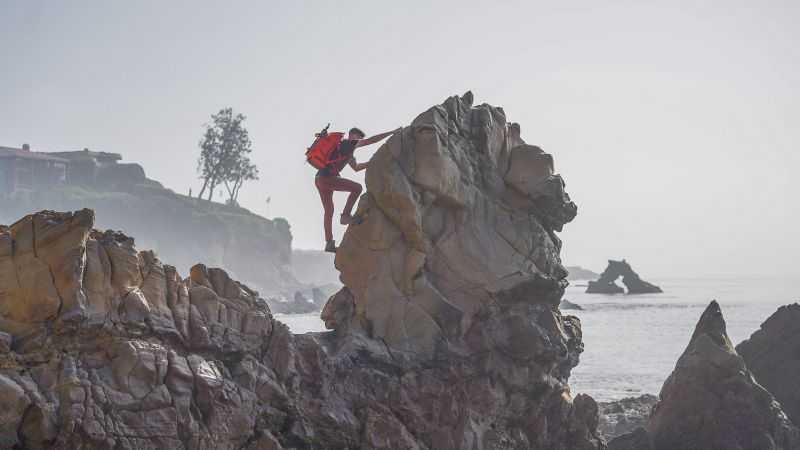
At a glance, you might think this was the $199 kit lens you got at a garage sale, or paired with an old Canon Rebel camera. Actually, nothing could be further from the truth! The Sigma 28-70mm f/2.8 DG DN Contemporary is the epitome of everything that is good about full-frame mirrorless: You get a bright, constant f/2.8 aperture, impressive image quality, in a compact, affordable package. This is exactly the type of lens that I had wished existed many years ago when full-frame mirrorless first came into existence!
The 2.5x zoom range is modest, sure, but then again, this lens is about as portable as many compact primes today!
For those DSLR photographers who always wanted your switch to mirrorless to involve lightweight, compact “miracle” lenses, here you go. For those of you who are buying your first mirrorless and/or first full-frame camera, this should be your first lens, too!
If you’re looking for a high-quality mid-range zoom, this is my current top choice. for anyone who values portability.
Check Pricing & Availability
The Sigma 28-70mm f/2.8 DG DN C is available for either $799 or $899 depending on the active discount:
(B&H | Adorama | Amazon)
Image Quality

Did Sigma cut off more than just 4mm to get to a more compact, affordable workhorse zoom? The Sigma 28-70mm f2.8 has lovely, deep, often golden colors. Plus, at the long end, photographers will get some great, soft bokeh. But, the edges aren’t sharp at all and there’s some barrel distortion and vignetting to contend with.
Bokeh

The bokeh from this lens doesn’t look like it’s coming from a budget-friendly zoom. If you use the full length of the lens and get in close, the subject really pops off a nice, soft background. Of course, it’s nothing like a brighter prime, but it’s quite good for the category.
Bokeh balls are also easy to create. And the things that many photographers complain about aren’t there. There’s no onion ring or soap bubble effect. Bokeh has nice soft edges.
Sharpness

At the center, the lens gets some great sharpness. It has that ideal balance where the eyes are sharp, but you don’t see every single pore.
But, looking at the edges and corners, it’s a different story. The edges are quite soft, both at the wide end, the telephoto, and at 50mm. If you go outside the Rule of Thirds lines, the subject is going to be a bit soft. Corner sharpness doesn’t really improve until you start hitting f5.6. Corner softness on a zoom is common, and, up until a few more modern mirrorless lenses, impossible to get away from. But, I’ve seen more and more edge-to-edge sharpness in lenses lately. Unfortunately, this lens isn’t one of them.
Lens Character

The Sigma 28-70mm f2.8 has some moderate pincushion and barrel distortion on the wide and telephoto ends. It’s not really obvious until you shoot something with straight lines towards the edges of the image. The wide-angle has the most bending at the edges. It can be corrected in post, but it’s there.
Pointed at direct sun, the Sigma will get a bit of fun starburst flare. If you adjust the angle of the glass a bit, you can get clean white flare, or get some dots of rainbow colors thrown in the mix. I couldn’t find chromatic aberration, much to my relief.
The lens also produces some light vignetting. It’s light enough to edit out if you don’t like it. It draws the eye in some shots, but looks out of place in others.
Color Rendering

I love the color coming from the Sigma 28-70mm f2.8. The colors are just a bit deeper but don’t fall into over-saturation. I felt like this lens captured more gold hues and, as a photographer who regularly edits more of that gold glow into my photos, I loved that. Color is typically one of my favorite things about Sigma lenses, and this one is no exception.
How does the image quality compare? Sigma 24-70mm f2.8 Art vs Sigma 28-70mm f2.8 Contemporary
Sigma claims that the optical performance “rivals” the similar Art line lens. After chatting with Editor-in-Chief Chris Gampat, who had the Art lens in his possession, I think this is mostly the case. Both lenses have some distortion at the wide-angle and some vignetting. They both deliver that nice rich color. And, both have a bit of corner softness.
But, I do think the Contemporary has more corner softness than the Art lens. On the flip side, the Art lens feels a little sharper at the center, which can highlight more skin imperfections. Either way, with the edge distortion, with both lenses you’re going to want to keep subjects away from the corners.
Field Curvature and Sharpness
Typically the standard 24-70mm is prone to field curvature issues – especially at the 24mm end. This lens starts at 28mm and is much more flat on its widest focal setting. There is a slight mustache curve with a slight pull towards the left, but for the most part is flat enough to not create severe focus issues.
To test this I used a technique that Roger Cicala at Lensrentals talks about quite often. I made an image of a flat surface with texture, in this case the asphalt on a street. I ran this through the “Find Edges” filter in Photoshop.
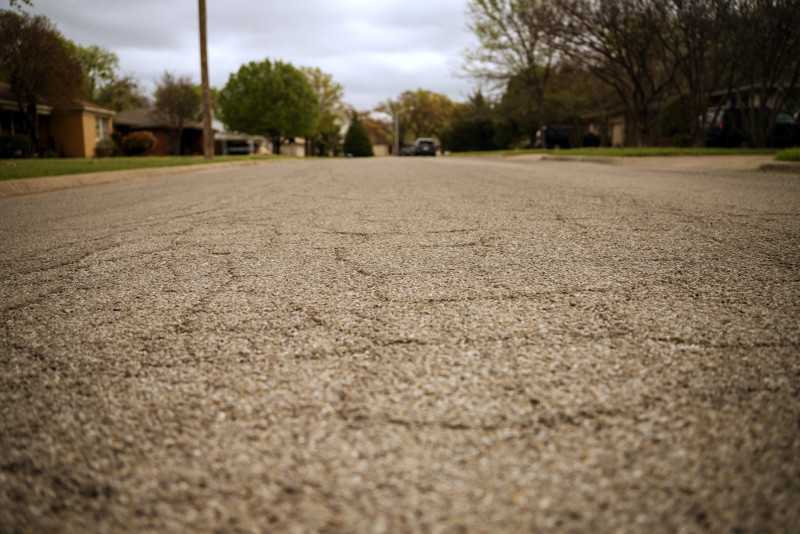
The “Find Edges” filter will separate anything sharp in the image by making it darker than the other areas. The examples below were all shot at f/2.8 and you are looking at the field of focus. I took three different photos at three separate focal lengths: 28mm, 50mm, and 70mm. You can see that the lens is fairly consistent throughout the range of the zoom.
 28mm
28mm
 50mm
50mm 70mm
70mm
Another thing you can see is how sharpness is best at the center of the lens and it shows that there is a slight fall off as we move to the edges of the frame.
This is somewhat to be expected on a zoom lens, and of course, will improve as you stop down. However, in practical use, I did find that I was losing sharpness even when I closed down the aperture. This might be an issue if you are looking for tack sharp landscape images, but for portraits and other general use where you’re less dependent on sharp corners, this shouldn’t be a major concern.
Sigma 28-70mm F2.8 DG DN | C: Verdict
The size and weight of a camera and the lens attached to it has a huge impact upon many photographer’s enthusiasm for carrying their kit ‘just in case’ or on a day out with the family. And while some full-frame mirrorless cameras are much smaller than the average full-frame DSLR, their lenses are often big and heavy – especially zooms with a constant f/2.8 aperture.
However, the Sigma 28-70mm F2.8 DG DN | C is impressively small, in fact, it can easily pass for a sub-full-frame lens with a smaller variable maximum aperture. It’s also dust and splash-proof yet it provides a major weight-saving on the Sigma 24-70mm F2.8 DG DN Art while still delivering very good image quality.
The Sigma 28-70mm F2.8 DG DN | C picks up four stars and AP’s Recommended Award
As a wide-angle fan, I occasionally missed the extra width afforded by a 24-70mm lens, but the Sigma 28-70mm F2.8 DG DN C proved itself to be a versatile lens with excellent close focusing, especially at its widest point, while the large aperture enables subject isolation from a nicely blurred background.
At £759, the Sigma 24-70mm f/2.8 DG OS HSM Art is attractively priced in comparison with a 24-70mm f/2.8 lens. Although spending more may bring more consistent results throughout the focal length range, it doesn’t feel like Sigma has built the lens to a price and it’s a shame that it’s not available in a wider range of mounts.
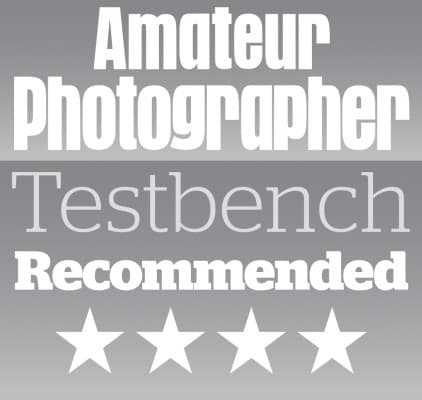
Caveats
As much as I like this lens, there are some things worth pointing out. No lens is perfect for every photographer and in optical design — there are always tradeoffs — but this might help if you’re deciding if this particular lens will fit your needs.

I mentioned earlier that I found corner sharpness falls off noticeably. This issue does mitigate slightly as you close down, but I still don’t see the resolution that someone who wants to shoot super-sharp landscapes would find acceptable. However, for any type of work where you would be looking for subject isolation, you shouldn’t have a problem — I think that is the strength of this lens.






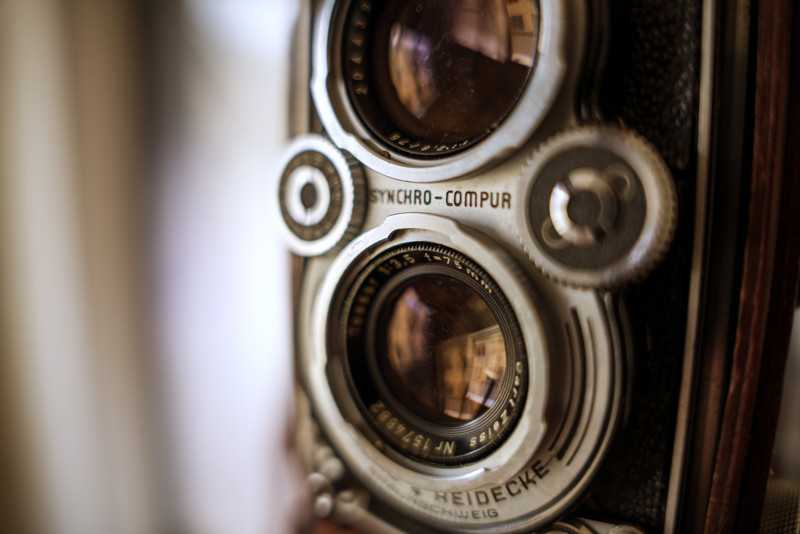
The short, close-focusing distance is nice to have, but this is not the optical strength of the lens. The image falls apart somewhat at super close distances and both lateral and longitudinal chromatic aberrations are visible. As a result, it’s a feature that’s a nice bonus but this lens is not going to replace a dedicated macro lens by any stretch.
Компактный зум для байонета E и L
Sigma предлагает 28-70 мм F2.8 DG DN Contemporary в двух версиях. Я тестировал версию с байонетом E, совместимую с камерами Sony, но вы также можете купить ее с байонетом L. Версия L совместима с беззеркальными камерами Leica, Panasonic и Sigma. За исключением крепления, две версии идентичны.
Это особенно привлекательный вариант для владельцев L-образных байонетов. Tamron не предлагает свои объективы для системы, и это единственный доступный тонкий зум с оптикой F2.8. Он конкурирует с более тяжелыми и дорогими Sigma 24-70mm F2.8 DG DN Art (1100 долларов США) и Panasonic Lumix 24-70mm F2.8 S Pro (2200 долларов США) и представляет собой очевидный недорогой вариант.
Объектив 28-70 мм меньше и легче, чем объективы 24-70 мм. Его размеры – 4,0 на 2,8 дюйма (HD), вес – 16,6 унции, и он поддерживает 67-миллиметровые передние фильтры. Он немного расширяется при масштабировании, как и Tamron 28-75 мм, но немного короче и на несколько унций легче в самом коротком положении.
В комплект входит бленда объектива, а также передняя и задняя крышки. Крепление объектива герметично для защиты камеры от пыли и брызг, а передний элемент содержит фтор, предотвращающий растекание пятен. Однако вы не получите внутренних уплотнений, которые входят в комплект поставки Sigma 24-70mm F2.8 или Tamron 28-75mm – оба варианта лучше, если вы хотите снимать в ненастную погоду.
Ствол выполнен из поликарбоната черного матового цвета. Он включает в себя тумблер AF / MF, кольцо масштабирования и кольцо ручной фокусировки. Регулятор зума расположен посередине корпуса и прорезинен с рельефной текстурой.
Sony a7R IV, 28 мм, f / 2,8, 1/400 секунды, ISO 100
Кольцо ручной фокусировки расположено дальше вперед, в передней части нетелескопической части ствола. Он тоже ребристый, но не прорезиненный. Он поворачивается с некоторым приятным сопротивлением и линейной реакцией – фокус меняется в зависимости от того, как далеко вы поворачиваете регулятор, а не от того, как быстро вы его меняете. Это один из плюсов использования видео, наряду с быстрой бесшумной автофокусировкой и минимальным эффектом дыхания.
Еще одна сильная сторона – фокусировка крупным планом. Он фиксирует объекты на расстоянии 7,5 дюймов при широком угле и 15 дюймов при увеличении, оба значения измеряются датчиком изображения. В любом случае вы можете оказаться на расстоянии нескольких дюймов от объекта. Увеличение составляет 1: 3,3 в натуральную величину в широкоугольном положении и 1: 4,6 в телеобъективе при максимально близкой фокусировке.
Sony a7R IV, 47 мм, f / 2,8, 1/800 секунды, ISO 100
Стабилизация в объектив не входит. Если вы используете полнокадровую камеру Sony, вам понравится 5-осевой IBIS со всеми моделями, кроме первого поколения, так что вы действительно не пропустите ее. Некоторые камеры с байонетом L, особенно компактная серия Sigma fp, не содержат IBIS.
The Practical Choice
Sigma has been producing outstanding lenses over the years. The company offers some very interesting options for a wide range of lens mounts and I really think the Contemporary line has a place with just about any photographer.
I will say that the 28-70mm f/2.8 DG DN is impressive in optical quality for its price. I don’t think optics are the argument here, so it is going to come down to price and size. If you’re on a tight budget, this lens is a winner and if you want to have a lens for carrying around all day that’s comfortable and lightweight I think this is the obvious choice. For me at least, less gear to haul around means more photographs because I’m not wasting time changing lenses which I think is the hidden strength of this lens.
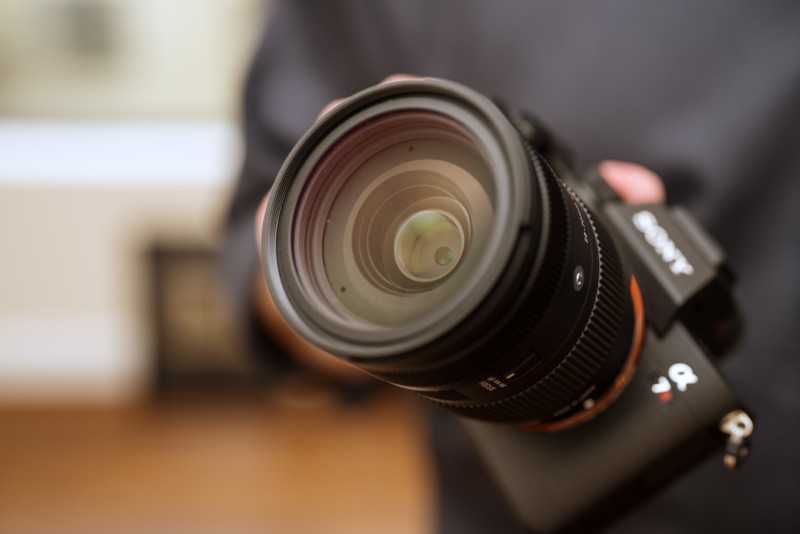
Are There Alternatives?
The Sigma 28-70mm f/2.8 DG DN is a very sensible option for a mid-range zoom. It’s a fairly unique focal length with only a few alternatives that match. Sony makes the 28-70mm f/3.5-5.6 OSS lens which is around half the price of the Sigma, but it is a variable aperture combined with a smaller base aperture which will turn many people off to it.
Certainly, another alternative would be to go with the more conventional 24-70mm f/2.8 configuration. You will get the extra 4mm on the wide end, but you will be looking at higher prices in exchange for that.
The Sigma 24-70mm f/2.8 Art is the closest choice here. It will run you another $200, but the tradeoffs are going to be down to the photographer. The cost is going to be a factor to some, but also consider the Art lens is going to be considerably larger and almost twice as heavy… but very good.
Should You Buy It?
Maybe. Every photographer is different and everyone has a different budget and different sets of expectations. If you are insistent on optical excellence corner to corner and are willing to add more weight and size to your lens to get it, then the Sigma 24-70mm f/2.8 Art is the better choice. As has been shown in the past, it’s really hard to beat from that perspective. But if your emphasis is on a compact and lightweight design that makes a few sacrifices, then there is a lot to like here.
A Compact Zoom for E- and L-Mount
Sigma offers the 28-70mm F2.8 DG DN Contemporary in two versions. I tested the E-mount edition, compatible with Sony cameras, but you can also buy it in L-mount too. The L version is compatible with mirrorless cameras from Leica, Panasonic, and Sigma. Aside from the mount, the two versions are identical.
(Jim Fisher)
It’s an especially appealing entry for L-mount owners. Tamron doesn’t offer its lenses for the system, and it’s the only slim zoom with F2.8 optics available. It competes with the heavier, pricier Sigma 24-70mm F2.8 DG DN Art ($1,100) and Panasonic Lumix 24-70mm F2.8 S Pro ($2,200), and is the clear value option.
Our Experts Have Tested 35 Products in the Lenses Category This Year
Since 1982, PCMag has tested and rated thousands of products to help you make better buying decisions. See how we test.
The 28-70mm is a smaller and lighter all around than those 24-70mm lenses. It measures 4.0 by 2.8 inches (HD), weighs 16.6 ounces, and supports 67mm front filters. It does extend a bit when zooming, just like the Tamron 28-75mm, but is a little bit shorter and a few ounces lighter at its shortest position.
Similar Products
(Jim Fisher)
A lens hood is included, along with front and rear caps. The lens mount is sealed to protect your camera from dust and splashes, and the front element includes anti-smudge fluorine. You don’t get the internal seals that are included with the Sigma 24-70mm F2.8 or Tamron 28-75mm, though—both are better choices if you wish to shoot in inclement weather.
The barrel is matte black polycarbonate. It includes an AF/MF toggle switch, a zoom ring, and a manual focus ring. The zoom control is positioned mid-barrel and is rubberized, with a ridged texture.
Sony a7R IV, 28mm, f/2.8, 1/400-second, ISO 100 (Jim Fisher)
The manual focus ring is further forward, positioned at the front of the non-telescoping portion of the barrel. It’s ridged too, but not rubberized. It turns with some pleasing resistance and a linear response—focus changes based on how far you turn the control, not how quickly you change it. It’s one of the plus marks for video use, along with quick, quiet autofocus and a minimal breathing effect.
Close-up focus is another strong suit. It locks onto subjects as close as 7.5 inches at the wide angle and 15 inches when zoomed in, both figures measured from the image sensor. You can get within a few inches of subjects either way. Magnification is 1:3.3 life-size at the wide angle and 1:4.6 at the telephoto end when focused as close as possible.
Sony a7R IV, 47mm, f/2.8, 1/800-second, ISO 100 (Jim Fisher)
Stabilization isn’t included in the lens. If you use a full-frame Sony camera, you’ll enjoy 5-axis IBIS with all but first-generation models, so you won’t really miss it. Some L-mount cameras, notably the compact Sigma fp series, don’t include IBIS.
Focus Performance
Sony A7 IV + Sigma 28-70mm f/2.8 DG DN | 1/1600 f/4 ISO 100
The focus performance of the Sigma 28-70mm f/2.8 is good. It’s snappy, accurate, smooth, and tracks well.
You will want something faster than f/2.8 in really dark situations but for shooting outside during daylight, I found the focus performance to be solid.
Overall the focus is better than Tamron and as good as a Sigma 24-70mm standard zoom lens. If you want a lightweight standard zoom lens, this is a great option.
Essentially I didn’t have any issues or concerns when it came to focusing – advances in technology are making this section of my reviews short and sweet. I don’t long for the days when I had to worry about finding focus.
With this lens, you will notice a minimal amount of focus breathing, but that’s common to many lenses. Some modern Sony cameras with Sony lenses can compensate for this but it isn’t available for this lens.
Ergonomics
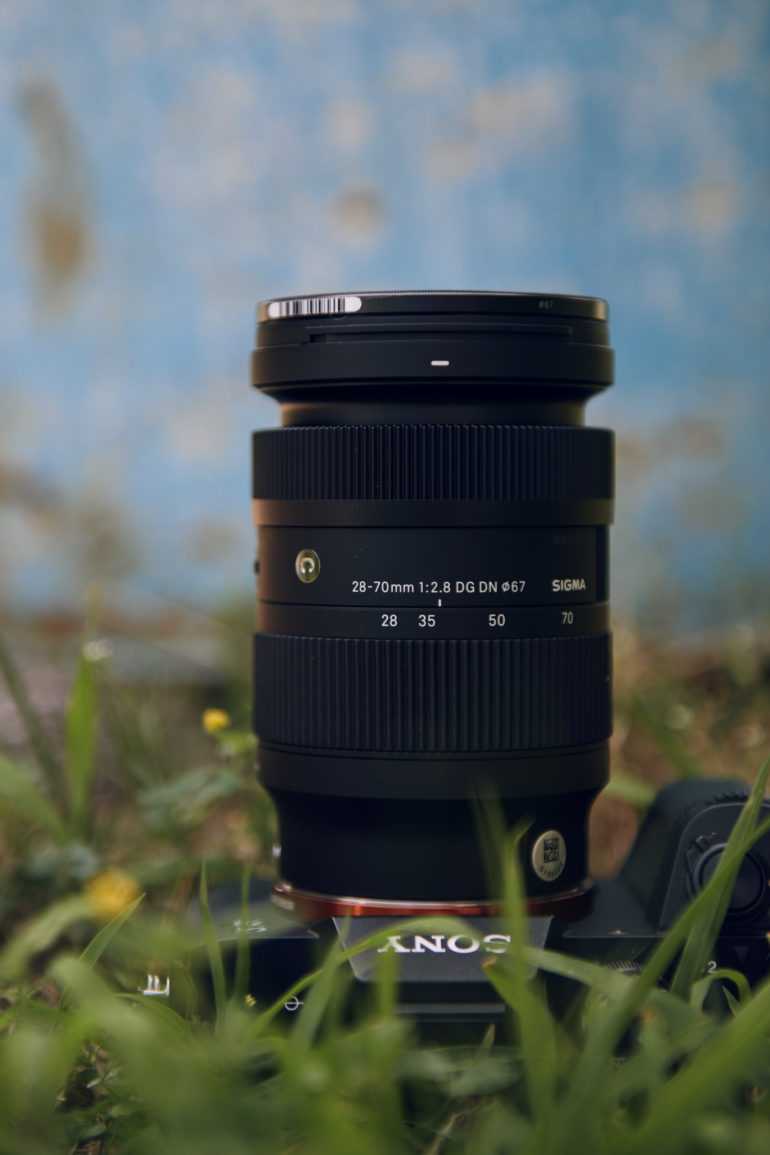
The Sigma 28-70mm f2.8 feels made for mirrorless. By cutting off 4mm on the wide-angle, Sigma crafts a workhorse lens that doesn’t feel like a workhorse. It’s nearly half the weight of Sony’s 24-70mm G Master: 14.6 ounces lighter. It’s smaller than the Sigma 24-70mm f2.8 Art lens and 12.8 ounces lighter. I use a 24-70mm f2.8 on a DSLR shooting weddings, and I’m sore by the end of the day. I’m jealous of how light this lens feels.
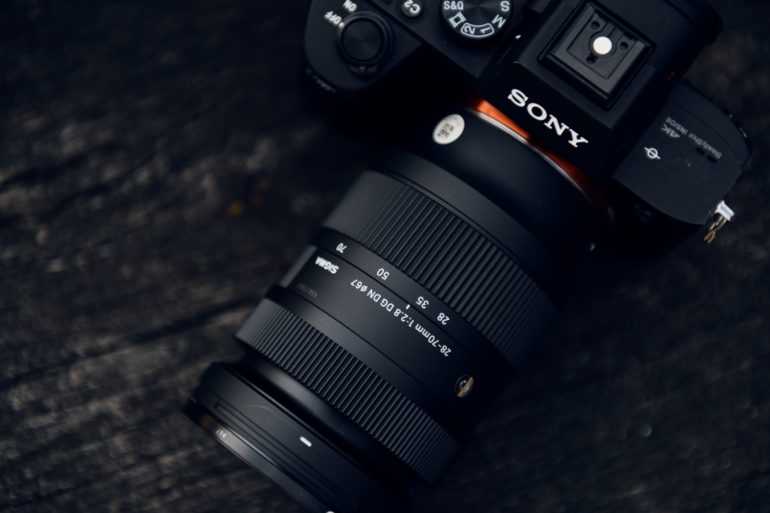
While light, the 28-70mm still feels great in the hands. The zoom has a pretty typical set-up with two control rings and a focus switch. The front-most ring, for focus, is narrower with a finer texture. The second ring, the zoom, is larger with a slightly different texture. I’m accustomed to a much larger zoom, so I reached for the wrong ring a few times before retraining my reflexes for a shorter optic.
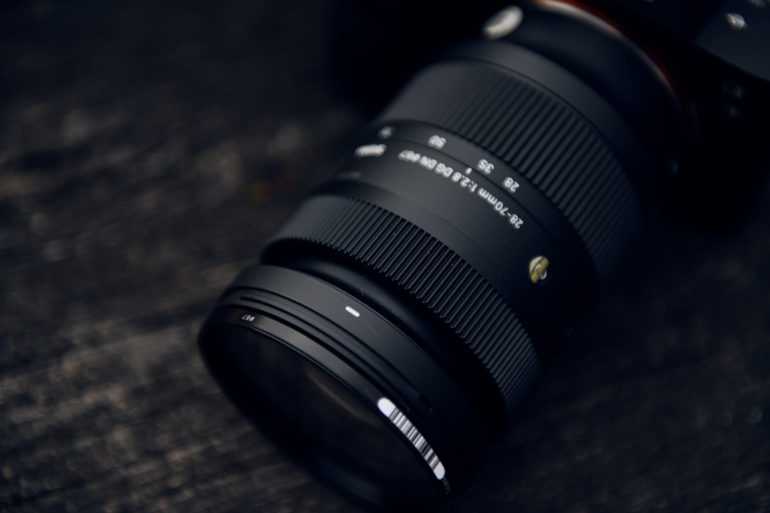
The only control besides the two rings is the auto to manual focus switch. I did accidentally hit the switch when pulling this lens out of my bag once. Beginners will want to familiarize themselves with that switch to troubleshoot if the lens suddenly doesn’t focus. There’s no focal length scale, but Sony’s own 24-70mm G Master doesn’t have one either. (It does, however, have a shortcut button, though a lot of photographers never use this feature.)
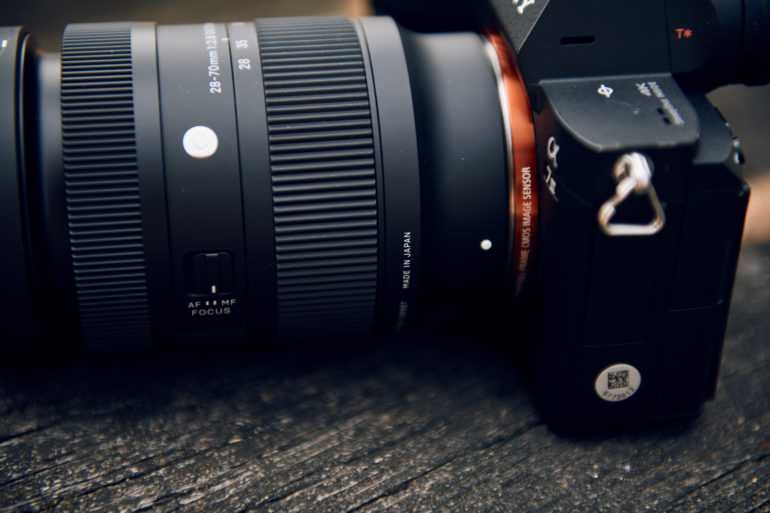
The lens has a flat front that accepts 67mm filters. It ships with a plastic lens hood.
Sigma 28-70mm F2.8 DG DN | C: Build & Handling
Thanks to a combination if its shortest focal length being 4mm longer and Sigma’s clever optical construction, the 28-70mm F2.8 DG DN | C weighs just 470g, which is 360g lighter than the Sony E-mount version of the 24-70mm f/2.8 DG DN | A. And at 101.5mm in length and 72.7mm in diameter, it’s 23mm shorter and 15.1mm narrower.
The lens works out 360g lighter than the Sigma 24-70mm f/2.8 DG DN | A
That may not sound much numerically, but it makes the 28-70mm much easier to slip in your bag, and it’s nicely sized for use on a Sony mirrorless camera such as the A7 III or A7R IV. It should also work nicely on smaller L-mount cameras such as the Panasonic Lumix S5 and Sigma fp or fp L.
Despite the lighter weight of the 28-70mm f/2.8, it has a high-quality build and it doesn’t feel plasticky or flimsy. Bucking the trend for additional buttons, switches and control rings, the lens has a simple design with a zoom ring, a manual focus ring and a switch to swap between manual and automatic focusing.
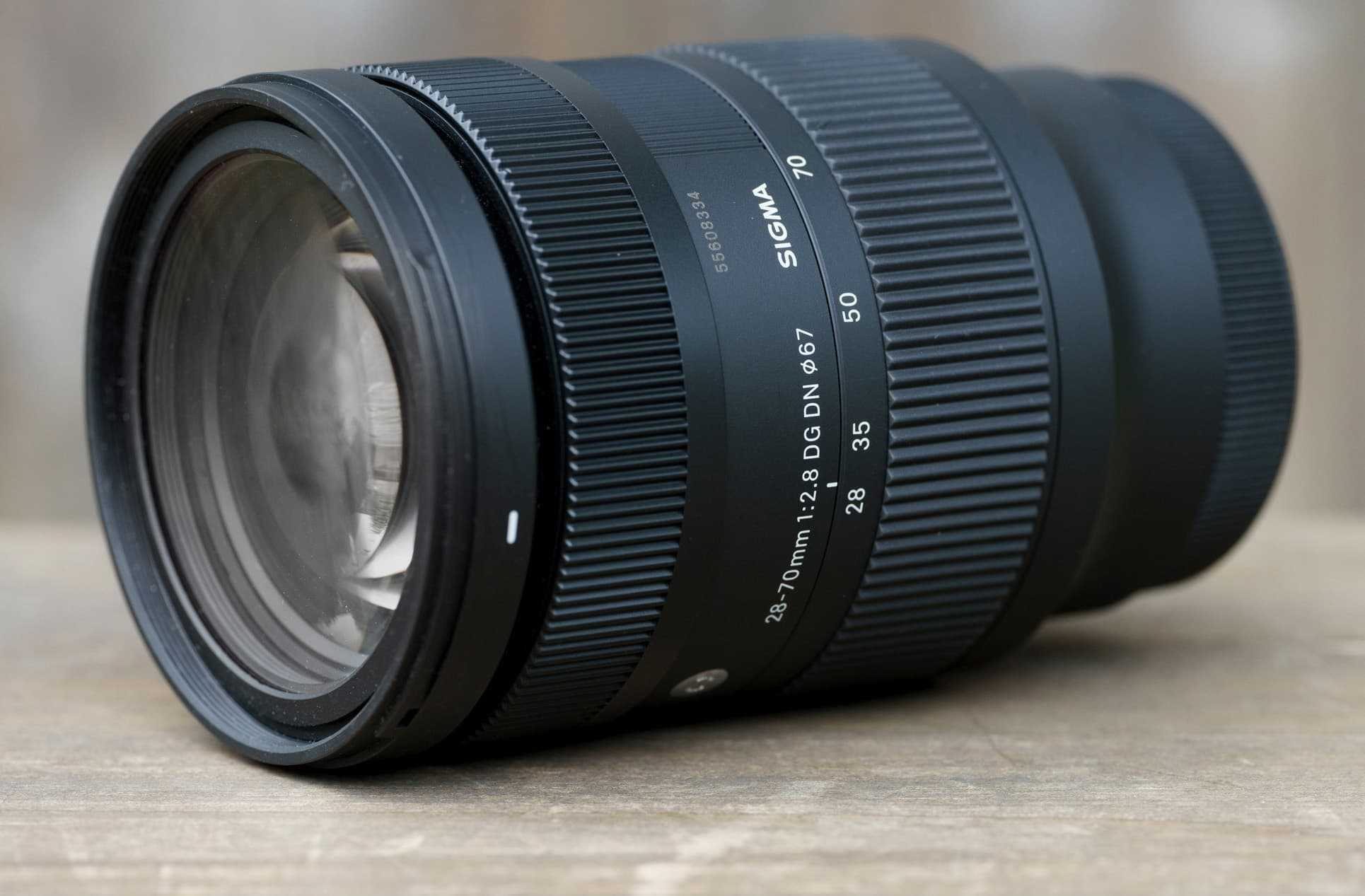
It accepts filters and adapters via a 67mm thread at the front
The zoom ring sits closest to the lens mount and it has a high-quality feel and smooth action, requiring pressure from your left forefinger and thumb to rotate it to the desired point. There are markings denoting the 28, 35, 50 and 70mm points.
Although there isn’t a zoom lock, I didn’t experience any zoom creep when the carrying the 28-70mm F2.8 DG DN | C mounted on a camera hanging from a strap across my body. Even shaking the camera doesn’t encourage the lens to extend from its shortest point.
The lens was tested on a variety of Sony E-mount mirrorless cameras
The focus ring isn’t quite as stiff as the zoom ring, which means it can be moved with pressure from just one finger, but it doesn’t feel slack and you can make precise adjustments.
When the AF/AMF switch is set to MF and MF Assist is activated in the menu, the Sony A7R IV magnifies the area under the AF point and a distance scale appears at the bottom of the viewfinder or the screen on the back of the camera.
A top view showing the size of the lens relative to a Sony E-mount mirrorless camera body
As usual, focusing is by wire so there’s no perceptible end point to the movement of the focus ring. instead, it’s just indicated by the distance scale in the viewfinder or on the screen.
Tech Specs
Sigma lists the following tech specs for the 28-70mm f2.8 DG DN Contemporary:
- Lens Construction: 12 groups, 16 elements (2 FLD elements, 2 SLD elements, 3 aspherical elements)
- Angle of View: 75.4°~34.3°
- Number of Diaphragm Blades: 9 (rounded diaphragm)
- Minimum Aperture: F22
- Minimum Focusing Distance: 19 (W)-38 (T)cm / 7.5(W)-15 (T)in.
- Maximum Magnification Ratio: 1:3.3 (W) – 1:4.6 (T)
- Filter size: φ67mm
- Dimensions (Diameter × Length)
- L-Mount: φ72.2mm×101.5mm / φ2.8in.×4.0in.
- Sony E-Mount: φ72.2mm×103.5mm / φ2.8in.×4.1in.
- Weight
- L-Mount: 470g / 16.6oz.
- Sony E-Mount: 470g / 16.6oz.
- Lens Hood (LH706-01) supplied
Sigma 28-70mm F2.8 DG DN | C: Image quality
There are correction profiles for the 28-70mm F2.8 DG DN | C that can be applied in-camera or during raw file editing. Without the profiles, vignetting is visible throughout the focal length range when the aperture is at its widest.
Sony Alpha 1, Sigma 28-70mm F2.8 DG DN | C @ 28mm, 1/30sec at f/11, ISO 100
Closing the aperture to f/4 reduces the vignetting significantly, and by f/5.6 it’s negligible. The in-camera and post-capture correction profiles also do a great job of dealing with it, although if I were to be hyper-picky, I’d say that the corner-brightening is a little stronger than it strictly needs to be at the widest apertures. That said, I think it’s very unlikely that this would be spotted in real-world shooting situations.
Sony A7R IV, Sigma 28-70mm F2.8 DG DN | C @ 28mm, 1/2000sec at f/2.8, ISO 100
Checking images at 100% on a computer screen reveals that the optics are generally sharp, especially at the wider end of the zoom range. Stopping down from f/2.8 to f/4 sees a very slight increase in sharpness at the 28mm point, but it’s more apparent at the long end of the lens.
Sony Alpha 1, Sigma 28-70mm F2.8 DG DN | C @ 38mm, 1/40sec at f/13, ISO 640
The detail-softening impact of diffraction also becomes more apparent at the telephoto end of the lens and while I would be happy to shoot with the lens wide-open at any focal length, shooting at between f/4 and f/16 ensures better results. As usual, there’s some fall off in sharpness towards the corners of the image, but it’s slight at the 28mm end of the lens and more noticeable at the longer focal lengths. Closing down to f/4 sharpens the corners up nicely.
Sony A7R IV, Sigma 28-70mm F2.8 DG DN | C @ 58mm, 1/60sec at f/18, ISO 100
In the absence of the correction profiles, there’s obvious barrel distortion at the 28mm end of the lens – at least if you photograph something with lots of straight lines. There’s also just perceptible barrel distortion at the 35mm point, while at 50mm and 70mm you may spot some pincushion distortion.
Sony Alpha 1, Sigma 28-70mm F2.8 DG DN | C @ 70mm, 1/200sec at f/2.8, ISO 100
Happily, the bowing lines are straightened in-camera or post-capture by the correction profiles, so they’re not really an issue. Similarly, the profiles also deal with the minimal chromatic aberration that I found along the odd high contrast edge. Further good news is that out-of-focus areas look smooth and naturally blurred while small highlights are round.
Sigma 28-70mm f/2.8 DG DN C Review | Compared To The Competition
There are two categories of competition with this lens. Just ask yourself this simple question: Are you happy with 28mm, or would you prefer 24mm?
Let’s say, for example, you’re looking at 28mm lenses because you want something compact and portable, and are willing to forfeit 24mm to save a little money and a few ounces/grams… This Sigma 28-70mm f/2.8 is the smallest option I would recommend because it is an excellent optic that doesn’t compromise.
Oppositely, the Sony 28-60mm f/4-5.6 is even smaller but has a slower, variable aperture and overall worse image quality. Even if you get one of these lenses “for free” with your Sony A7C, I’d still recommend trading it for this Sigma!
Going back even further in Sony E-mount history to where some truly sub-par lenses reside, the Sony 28-70mm f/3.5-5.6 (which seems like a bargain at under $400) is a poor performer overall, period. Save up the extra money for the Sigma!
Indeed, the only excellent alternatives I would consider are the Tamron 28-75mm f/2.8 G2, if you want a constant f/2.8 zoom, or the Tamron 28-200mm f/2.8-5.6 if you’d rather have a “superzoom” with more range on the long end.
The “G2” Tamron 28-75mm f/2.8 really is quite impressive, in fact, it is optically near-perfect just like the Sigma 28-70mm f/2.8. However, I do prefer the Sigma because it is even smaller, and has the AF/MF switch that I like, instead of the Fn button on the Tamron.
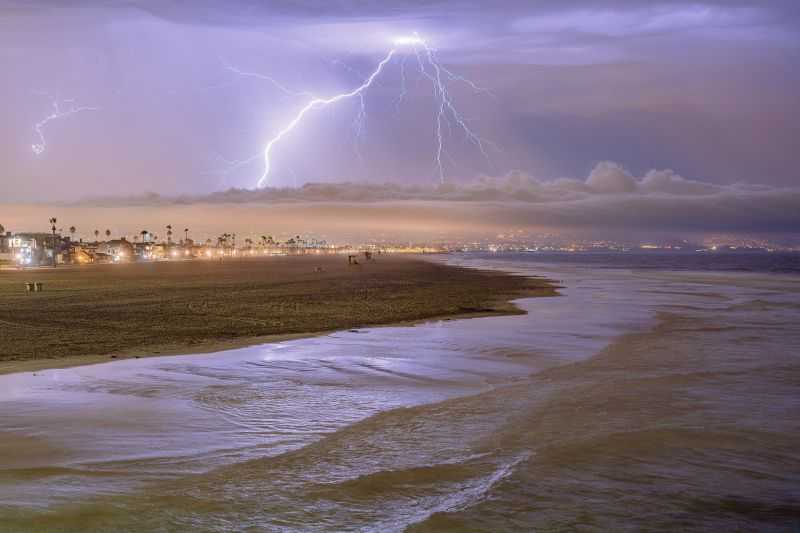
What if you’re quite sure that 28mm isn’t wide enough, though? Unfortunately, you’re not going to escape carrying around a slightly larger lens. The good news is, compared to the DSLR-oriented Sigma 24-70mm f/2.8 HSM Art, the new mirrorless (DG DN) version is actually decently portable, and the price tag isn’t much higher either.
[Related: Sigma 24-70mm f/2.8 DG DN Art Review | A Flagship Pro Lens For Half The Price!]
Alternately, if you want even more zoom range, Sony’s 24-105mm f/4 G is a good choice, especially if you’re more likely to be photographing landscapes or cityscapes at f/8 than you are likely to be photographing candids and portraits indoors at f/2.8, of course.
NOTE: I should mention that if you are not a Sony camera owner yet, and are still shopping for a full-frame mirrorless body, you can consider the brand-new Nikon Z-mount 28-75mm f/2.8 which was just announced for Nikon’s impressive Z-mount lineup. Canon, on the other hand, does not have a compact, lightweight f/2.8 RF-mount lens; they have the incredibly slow (aperture) 24-105mm f/4-7.1 RF.
All in all, the Sigma 28-70mm f/2.8 is really quite unique because of its compact size. It looks like a miniature version of a flagship lens, almost as if you’d mounted an APS-C lens by accident. So, if portability is important to you, this is simply the best mid-range zoom I’ve ever gotten my hands on.
Sigma 28-70mm f/2.8 DG DN Contemporary Specifications
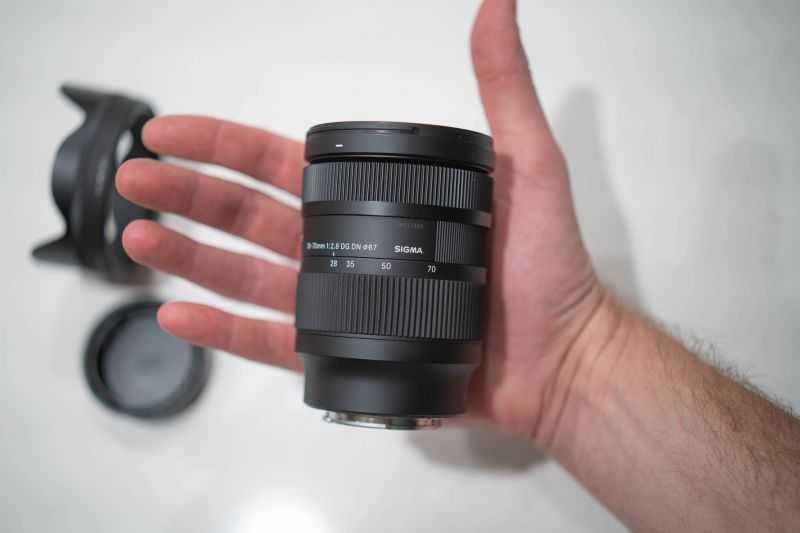
- FOCAL LENGHT & ANGLE OF VIEW: 28-70mm (75.4° to 34.3°) 2.5x zoom ratio
- LENS MOUNT(S): Sony E, (full-frame) Leica L / Sigma / Panasonic (full-frame)
- APERTURE & RANGE: Constant f/2.8, 9-blade rounded aperture
- STABILIZATION: No
- AUTOFOCUS: Stepper motor, near-silent
- MANUAL FOCUS: Electronically controlled, focus distance displayed on camera
- OPTICAL CONSTRUCTION: 16 elements in 12 groups, 3 aspherical, 2 FLD, 2 SLD
- MECHANICAL CONSTRUCTION: Metal & plastic, (brass mount) weather-sealed (extends when zooming)
- MAGNIFICATION & FOCUS DISTANCE: 1:3.3 magnification, 7.5″ focus distance (at 28mm)
- FILTER THREADS & HOOD: 67mm, rubber-grip bayonet hoood
- SIZE: 2.8 x 4″ / 72.2 x 101.5 mm
- WEIGHT: 470 g (1.04 lb)
- PRICE: $799 (or $899 when not on sale)(B&H | Adorama | Amazon)




























